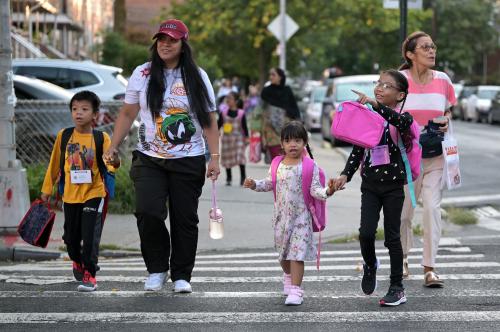This Monday, in a move that deserved more attention than it received, the White House announced a new program to expand computer science education. The centerpiece is an agreement involving more than 60 school districts, including the seven largest in the country, to offer computer science education to their students. $20 million in philanthropic contributions will help train 10,000 teachers by the fall of 2015 and 25,000 by the time the school year begins in the fall of 2016. In partnership with the National Science Foundation, the College Board will develop a new Advanced Placement course in computer science, and organizations such as Teach for America and the National Math and Science Initiative will help implement this course in thousands of classrooms. And a broad-based campaign will encourage greater participation by women and minorities in this field.
The Obama administration acted against the background of a growing, urgent problem that until recently went largely unrecognized. Last April, the Washington Post’s Donna St. George reported that although their lives “swirl in technology,” the nation’s high school students “spend little time studying the computer science that is the basis of it all. Few are taught to write lines of code, and few take classes that delve into the working of the Internet or explain how to create an app.” Most schools have no organized curricula on these subjects, and many don’t offer as much as a single course—including 10 of 27 high schools in Virginia’s Fairfax County and 6 of 25 in Maryland’s Montgomery County.
These counties are among the wealthiest in the nation, and their school systems enjoy a reputation for excellence. As one might imagine, then, the situation is worse almost everywhere else. Nationwide, only one in ten schools provides computer science instruction, and Advanced Placement computer science is available in only 5 percent of high schools. It comes as no surprise, then, that fewer than 30 thousand high school students took the AP exam in computer science, compared to more than 270 thousand who took the most popular AP calculus exam. Of those taking the test, only 18 percent were women, and only 12 percent were black or Hispanic.
This shortfall ripples through the educational pipeline. In 2012, only 35 thousand college students majored in computer science. This is significantly lower than the nearly 50 thousand computer science majors as recently as 2003 and represents only a fraction of an estimated 150 thousand new employees with computer skills that employers will need each year. As the demand for computing expertise soars, our schools and students seem to be moving in the other direction—despite the fact that jobs in this area typically offer higher-than-average compensation and opportunities to advance.
The challenge extends well beyond professions that involve coding and information architecture. As noted labor economists Richard Murnane and Frank Levy have shown, the skills required throughout the workforce are changing dramatically. As technology eliminates routine cognitive tasks, jobs will increasingly demand the ability to work with new information and to solve unstructured problems. These are the kinds of skills that computer science courses are most likely to develop, and not only for students who go on to major in the subject.
There is no good reason why young Americans shouldn’t have a chance to study this subject, which is why President Obama in his 2015 State of the Union address should announce an ambitious goal for our nation: By the academic year 2020-21, courses in computer science should be available to every student.
Visionary organizations have already laid a solid foundation. Code.org, a pioneer in this field, has prepared materials for elementary, middle, and high school students, including two courses at the high school level. The Computer Science Teachers Association has developed rigorous goals and standards for a K-12 computer science curriculum. Microsoft has provided funding for a grass-roots effort, Technology Education and Literacy in Schools (TEALS), which brings employees of Microsoft and other tech firms into classrooms to teach basic computer science and coding.
This nascent movement extends beyond individual classes to reinvent entire learning institutions. A collaboration between the New York City Schools, the City University of New York, and IBM, has created P-TECH, a 21st century vocational school whose six-year program integrates high school and college STEM courses. Graduates will receive associates’ degrees in computers or engineering along with their high school diplomas. Along the way, students will use programming assignments and real-world case studies to develop critical thinking skills and the ability to solve unstructured problems that employers increasingly prize.
To bring computer education to every school, however, these bottom-up efforts will need top-down support. Monday’s announcement was a great beginning, but sustained follow-through is essential. Not only Mr. Obama, but also the next president should make a firm commitment to this national goal and challenge the country to mobilize behind it.
This may sound fanciful, but it’s not. I was just beginning high school when the Russians launched Sputnik. By 1960, the MIT-based Physical Science Study Committee (PSSC), led by many of the nation’s most distinguished physicists, had responded with a new physics textbook, instructional videos, and other classroom materials that were used by high schools in the United States and around the world. Even before the textbook appeared, my physics class was using mimeographed materials our teacher received hot off the press from the PSSC as they were being developed and tested. The excitement was palpable, and we responded with enthusiasm.
Half a century ago, our principal challenge was military. Today it is economic—and social. Our educational system, which once led the world, is falling behind international standards—especially in STEM subjects. Because too few of our students are equipped to fill the jobs of the future, too many are being consigned to jobs that offer limited prospects for upward mobility. As the middle of the labor force is being hollowed out, the middle class is shrinking, and class divisions are exacerbating ideological clashes.
Universal computer science education may not be the silver bullet, but it is a lot more promising than most of the reforms we’ve tried over the past three decades. The question before us is whether we believe—or whether new leaders can persuade us—that our economic challenges are no less urgent today than was our competition with the Soviet Union in the 1950s and deserve an equivalent response.



Commentary
Computer Science Courses for Every Student by 2020
December 11, 2014